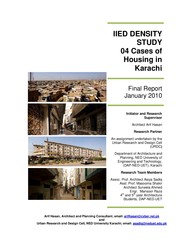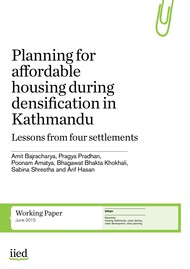Case studies on urban density from Karachi, Bangkok and Kathmandu
IIED, in collaboration with local partners, undertook a project to redefine the role of urban density for low-income groups. The project, led by Arif Hasan, ran from 2009-15 and discovered ways to make high-density settlements more comfortable and sustainable. Case studies from Karachi, Bangkok, and Kathmandu are presented here.

Overview of the Nawalane neighbourhood, one of the oldest settlements of Karachi (Photo: Fareena Chanda)
Exploring high-density housing solutions in Karachi
Karachi is one of the world’s fastest growing megacities and Pakistan's commercial hub. In 2010 it housed over 15 million people. However, the pace of commerce in the city can’t mask the reality of poverty, with over 72% of the population living on less than $2 a day.
The city grapples with poverty and the influx of migrants, resulting in a proliferation of informal settlements, known as katchi abadis. These communities are marginalised and vulnerable to forced evictions, as part of urban 'upgrading' efforts, contributing to the increasing divide between rich and poor.
Four case studies planning for high density in low-income settlements
In a study by Arif Hasan, Asiya Sadiq and Suneela Ahmed, four low- to lower-middle-income housing sites in Karachi were analysed to challenge conventional notions of housing density. A hypothetical redesign exercise showed how high-density settlements could be constructed on these sites without compromising on living conditions.
The researchers aimed to explore whether alternative high-density designs could be developed for settlements with low-rise, flexible housing, moving away from the prevailing trend of high-rise apartments.
The significance of this research lies in its potential to achieve high density that is both comfortable and sustainable over time, providing affordable housing solutions for both growing families and entrepreneurial activities.
The findings reveal that high-density settlements can be achieved without resorting exclusively to high-rise apartments. Housing designs based on small plots, allowing for incremental growth, are demonstrably preferable to high rises.
This study has broader implications for crowded cities around the world, as it offers an alternative path to addressing the housing needs of nearly a billion people residing in informal settlements.
Housing density and preference in Bangkok
Ensuring decent, affordable and accessible housing for all urban residents remains a pressing goal, particularly in large cities like Bangkok, which had an official population of eight million in 2010. However, the pursuit of adequate housing faces complexities arising from competing land pressures and the influence of private developers in shaping housing markets.
While high-rise constructions aim to maximise land use, catering to the lower-income bracket remains a challenge. Low-income households have historically moved into informal settlements where neither household nor settlement density may conform to official standards.
Past approaches in Thailand, from public housing to innovative initiatives, have struggled due to land availability.
In 2003 Thailand adopted a two-pronged approach to housing: demand-driven, through the innovative Baan Mankong participatory slum upgrading programme (Boonyabancha, 2005); and supply-driven, through the public housing approach of Baan Ua-Arthorn. Only Baan Mankong continues to be implemented today.
This study examined housing preferences among low and lower-middle-income communities and how these preferences related to population and housing density across various low-income housing types. It challenged the traditional view of overcrowded informal settlements and looked at whether high density is observed in practice in community-driven and public housing projects.
Baan Mankong represents community-driven housing, while National Housing Authority (NHA) flats represent public housing projects. The research also investigated how varying densities impact residents' satisfaction levels with their neighbourhood.
The study examines population density's relationship with density levels, socio-economic conditions, and satisfaction rates across these housing types. This provides insight into the influence of building regulations, government policies and broader implications for urban development processes.
Although based on a limited number of settlements, the study reveals NHA settlements are densely populated at a settlement scale, despite having open spaces. Conversely, the non-upgraded Wat Phrayakrai settlement challenges the notion of overcrowded slums.
Individual homes in the Wat Phrayakrai slum are densely inhabited. Satisfaction levels are highest in the Baan Mankong upgraded communities, attributed to participatory design. Satisfaction appears linked to density across the housing types.
The results suggest that housing approaches involving resident input in design offer the most satisfactory conditions for low-income communities. Consequently, government-supported housing programs should embrace participatory approaches.
For a comprehensive look at this study, the full report is available for download.
Somsook Boonyabancha, secretary-general of the Asian Coalition for Housing Rights (ACHR), was interviewed by IIED and responded to some key questions about urban density. Part one and part two are available to watch.
The challenge of affordable housing in Kathmandu
Kathmandu, with its population exceeding one million and a growth rate above 4.5%, is struggling to keep pace with growing demand for affordable housing. Zoning bylaws and building regulations, which often impose excessive restrictions on development, exacerbate the housing scarcity.
The quest for housing solutions often pushes development beyond legal boundaries, resulting in haphazard densification. While this increases affordable housing options, particularly in the informal rental sector, it compromises living conditions and services, and increases crowding.
For a comprehensive understanding, the complete study is available for download.
Other cities
You may also be interested in research materials exploring alternative routes to urban density in other cities. Resources are from IIED or links to external sources.
Colombo, Sri Lanka
The efforts of a federation of slum and shanty dwellers to secure land and improve housing in Moratuwa: from savings groups to citywide strategies, Celine D'Cruz, Gordon McGranahan, Upali Sumithre (2009), Environment & Urbanization Volume 21, Issue 2
Lahore, Pakistan
The redesigning of Saiban City, Lahore, Arif Hasan (2012), Report








